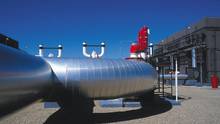TransCanada's Keystone line failing safety rules: regulator
 Canada’s National Energy Board, in a letter dated Aug. 17, says TransCanada Corp. is not meeting certain safety standards on its Keystone system in Saskatchewan and Manitoba.
Canada’s National Energy Board, in a letter dated Aug. 17, says TransCanada Corp. is not meeting certain safety standards on its Keystone system in Saskatchewan and Manitoba.In June, 2011, NEB inspectors found pump stations in four locations did not have an “alternate source of power capable of operating each station’s emergency shut-down system,” and therefore TransCanada was in non-compliance with the board’s regulations.
TransCanada replied in July, 2011, saying it “considered itself compliant” and explained its mitigation measures, according to the NEB. After reviewing more information, the NEB disagreed and has denied the company relief.
“TransCanada has not demonstrated that its current mitigation measures provide a level of safety that is equivalent to that provided” by the regulator. As a result, TransCanada must file a “corrective action plan” to install alternate sources of power at all of the Keystone pumps under the NEB’s jurisdiction by Sept. 17. This plan, the NEB said, will ensure the corrective measures are in place by September, 2013.
The Calgary-based pipeline company maintains its shut-down method is adequate. “TransCanada operators can remotely close nearby mainline valves so this provides an appropriate isolation that is equivalent to a backup power source activating station valves at the stations,” James Millar, a spokesperson for the company, said in a statement. “Pump stations also have battery back-up power and all alarms are still visible to our control centre operators who monitor the pipeline system 24/7.
“We also felt that closing the valves remotely enabled us to avoid constructing power generators and fuel tanks on-site at pump stations, something that could have a negative impact on GHG emissions and also could pose a spill risk to the environment as diesel fuel needs to be replaced annually,” he said.
However, because TransCanada’s appeal was rejected, it will install the additional backup equipment the NEB demands. The company does not know how much this will cost yet, Mr. Millar said.
Pipeline safety is a divisive topic in Canada and the United States as TransCanada lobbies to expand its network to connect with refineries on the Gulf Coast. Pump stations control the flow of crude, making them key in limiting damage after pipeline spill.
You can return to the main Market News page, or press the Back button on your browser.

